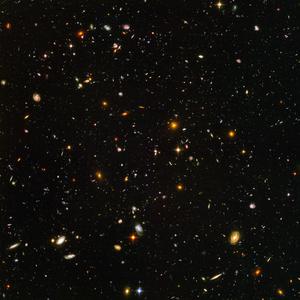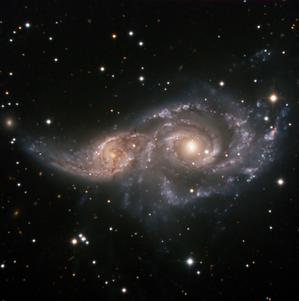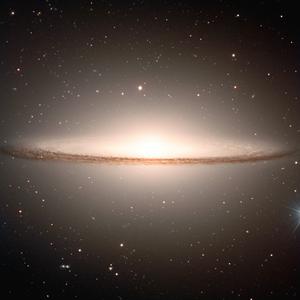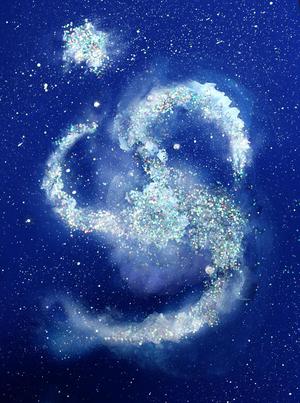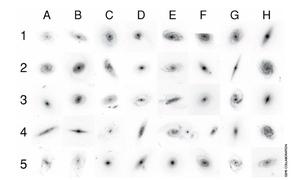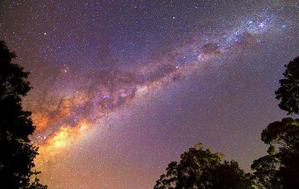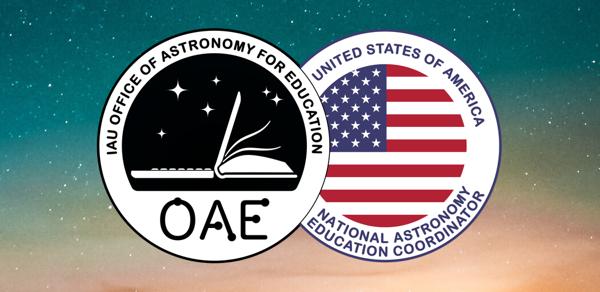Glossarbegriffe: Galaxie
Description: Eine Galaxie ist eine Ansammlung aus Sternen und anderen Bestandteilen wie Dunkler Materie, Gas und Staub, die durch die Schwerkraft zusammengehalten wird. Die Entfernung zwischen zwei benachbarten Galaxien beträgt üblicherweise Hunderttausende von Lichtjahren. Galaxien gibt es in verschiedenen Formen und Größen. Die kleinsten Galaxien können nur einige Tausend Sterne enthalten, während es in den größten Galaxien mehrere Billionen Sterne geben kann. Unsere Heimatgalaxie, die Milchstraße, wird auch als "Galaxis" bezeichnet. In ihr befinden sich ungefähr 100 bis 400 Milliarden Sterne.
Zugehörige Glossarbegriffe:
- Dunkle Materie
- Scheibengalaxie
- Staub
- Zwerggalaxie
- Elliptische Galaxie
- Galaktischer Bulge
- Galaktisches Zentrum
- Galaktische Scheibe
- Galaktischer Halo
- Galaxienhaufen
- Gas
- Greenwich Mean Time (GMT)
- Irreguläre Galaxie
- Milchstraße
- Spiralgalaxie
- Stern
- Galaktischer Balken
- Linsenförmige Galaxie
See this term in other languages
Term and definition status: The original definition of this term in English have been approved by a research astronomer and a teacher The translation of this term and its definition is still awaiting approval
The OAE Multilingual Glossary is a project of the IAU Office of Astronomy for Education (OAE) in collaboration with the IAU Office of Astronomy Outreach (OAO). The terms and definitions were chosen, written and reviewed by a collective effort from the OAE, the OAE Centers and Nodes, the OAE National Astronomy Education Coordinators (NAECs) and other volunteers. You can find a full list of credits here. All glossary terms and their definitions are released under a Creative Commons CC BY-4.0 license and should be credited to "IAU OAE".
Zugehörige Medien
Hubble Ultra Deep Field
Bildnachweis: NASA, ESA, and S. Beckwith (STScI) and the HUDF Team credit link
License: CC-BY-4.0 Creative Commons Namensnennung 4.0 International (CC BY 4.0) icons
Spiral Galaxy Merger
Bildnachweis: ESO credit link
License: CC-BY-4.0 Creative Commons Namensnennung 4.0 International (CC BY 4.0) icons
Sombrero galaxy
Bildnachweis: ESO/P. Barthel credit link
License: CC-BY-4.0 Creative Commons Namensnennung 4.0 International (CC BY 4.0) icons
Related Activities
Glitter Your Milky Way
astroEDU educational activity (links to astroEDU website) Description: Explore the Milky Way and characteristics of galaxies using glitter drawing.License: CC-BY-4.0 Creative Commons Namensnennung 4.0 International (CC BY 4.0) icons
Tags: Art , Creativity , Hands-on , Handcraft Age Ranges: 6-8 , 8-10 Education Level: Middle School , Primary Areas of Learning: Fine Art focussed Costs: Medium Cost Group Size: Group Skills: Communicating informationComa Cluster of Galaxies
astroEDU educational activity (links to astroEDU website) Description: The basics of galaxy classification, using Hubble Space Telescope images.License: CC-BY-4.0 Creative Commons Namensnennung 4.0 International (CC BY 4.0) icons
Tags: Coma Cluster Age Ranges: 14-16 , 16-19 , 19+ Education Level: Secondary , University Areas of Learning: Guided-discovery learning Costs: Low Cost Duration: 1 hour Group Size: Group Skills: Analysing and interpreting data , Communicating information , Constructing explanations , Planning and carrying out investigationsLiving in the Milky Way
astroEDU educational activity (links to astroEDU website) Description: Build a model of the Milky Way to discover what our galaxy contains.License: CC-BY-4.0 Creative Commons Namensnennung 4.0 International (CC BY 4.0) icons
Tags: Hands-on , Model Age Ranges: 6-8 , 8-10 Education Level: Primary Areas of Learning: Problem-solving , Social Research Costs: Medium Cost Duration: 1 hour 30 mins Group Size: Group Skills: Asking questions , Communicating information , Developing and using models